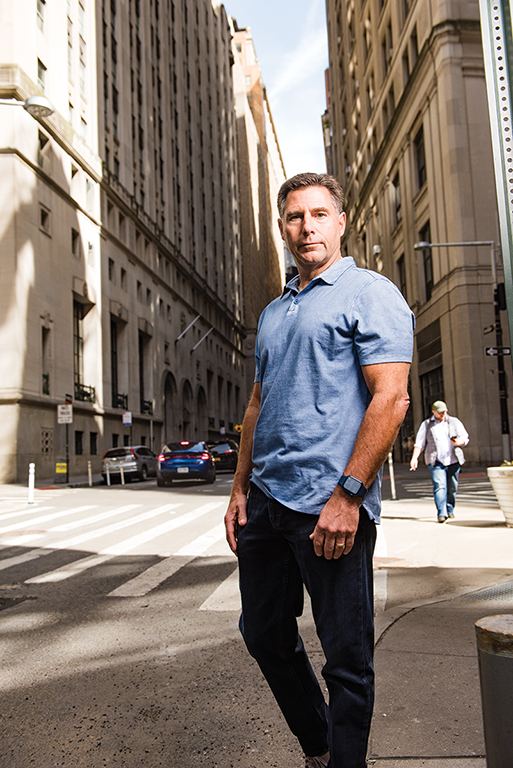Crypto 101
Cryptocurrency has gained a foothold in global economics and shows no signs of slowing down. But what the heck is it? We turn to two alumni for the basics.

Our authority on cryptocurrency, Jeff Horowitz.
Cryptocurrency has gained a foothold in global economics and shows no signs of slowing down. But what the heck is it? We turn to two alumni for the basics.
When it comes to our traditional financial institutions, the phrase cash is king is widely accepted as truth. That is, cash — our government-printed money — is perceived as more valuable than any other form of investment, especially in times of economic uncertainty. Today, however, with the rise of cryptocurrencies (cash’s digital relatives), some wonder if the king is set to be dethroned.
Simply put, crypto is a digital asset that isn’t issued by the U.S. government and is named for its cryptography (computer coding that authenticates and secures it). Created in 2009 amid a banking crisis that left some Americans with a distrust of our central system, the popularity of cryptocurrency has surged in recent years.
But for many of us, understanding this new asset is anything but simple. That’s where two alumni experts come in. Meet Jeff Horowitz ’90, chief compliance officer at BitGo, and Dennis O’Connell ’09, chief technology officer of the PSG Peregrine Digital Institutional Cryptocurrency Fund and acting director of decentralized finance product at Securrency. They are here to give a primer of what cryptocurrency is, how it works, and why there’s so much buzz around it.
- Our authority on cryptocurrency, Jeff Horowitz.
- Our blockchain expert, Dennis O’Connell.
TCNJ Magazine: Let’s start with the basics. What exactly is cryptocurrency?
Jeff Horowitz: Cryptocurrency is a digital asset designed to be a medium of exchange, like gold, with a variable price attached to it based on supply and demand. The difference is cryptocurrencies aren’t physical like gold; they are digital.
TM: So when we hear the term Bitcoin, which was the first cryptocurrency, that’s not a coin you can touch like a penny; it just exists in digital form?
Dennis O’Connell: Correct. A cryptocurrency, like Bitcoin, is digital money you can use on the internet. It is a new way of expressing value and ownership. And instead of a bank determining that value and who owns it, it is done through a technology called blockchain.
TM: OK, stop. What is a blockchain?
JH: A blockchain is essentially a ledger that anyone can view. Instead of traditional banks that independently keep track of your balances, your cryptocurrency balances are recorded on the blockchain’s ledger.
DO: Blockchain technology is the infrastructure for cryptocurrency and is run by a large network of computers, with each computer holding an exact copy of the ledger. You can think of the ledger as an Excel spreadsheet, but when you think of where an Excel spreadsheet exists, you might say, “Oh, it’s on my computer.” You have a single location where it exists and nowhere else. In the blockchain, that ledger is distributed everywhere, among a network of computers.
JH: For example, after you buy Bitcoin, the Bitcoin network will acknowledge your purchase on the ledger. The goal of the blockchain is to distribute these validated records and transactions among a community rather than one company or bank. Validation via consensus is a new way of thinking about how to record information.
TM: And that validation via consensus, is that where the term “mining” comes in? The miners are the ones who are confirming transactions are legit?
JH: Yes. Cryptocurrency networks need to make sure that nobody spends the same money twice; there is no bank or Visa or PayPal in the middle validating transactions and balances. “Mining” is the way the network confirms new transactions and adds them to the blockchain. It is performed using sophisticated hardware that solves an extremely complex computational math problem. The key to crypto is there is no central authority. The community is the authority. And the community competes to solve the math problem to confirm the transaction.
TM: Then once that transaction is validated, where does the cryptocurrency go?
JH: In a traditional bank transaction, you would go to your bank website to see that you have $10,000 in your savings account and then ask the bank to send $5,000 of that to a friend’s bank account, leaving you with $5,000. Both banks in this scenario would keep independent records of balances. However, with crypto, your balances are reflected in a wallet address on a public blockchain.
DO: Your wallet acts as your savings account and is identified by an address of random numbers and letters. You can then directly access the blockchain through a website, browser plugin, or mobile app to check your balance, withdraw, or send crypto to someone else.
TM: So then how do two individuals exchange crypto?
JH: Let’s say your wallet address is 12345TCNJ. Your friend’s address is TSC12345. You’d type in your friend’s wallet address and initiate a transaction to send one Bitcoin worth $38,000 from your wallet to your friend’s wallet. The networks around the world would read the open blockchain request to see if 12345TCNJ had $38,000 worth of Bitcoin to send. It would take 6-10 computers to agree that your wallet owns that amount, and it would then update the blockchain. It would then reflect the new balances in both the TCNJ wallet and the TSC wallet. Once those computers agree that the ledger is still balanced, it would add that block of transactional information to the previous block.
TM: How do I know my cryptocurrency is safe?
DO: You have a key for your wallet. When you create an account, you’re given three things: an address, a public key, and a private key. You are responsible for, and the only one who has, your private key, so it is secure.
TM: How do cryptocurrencies get their value?
JH: The gold example is pretty accurate here too. Gold’s value fluctuates based on supply and demand, or what someone thinks owning an ounce of it is worth. There can only be so much gold dug out of the earth. Each type of cryptocurrency functions in its own way like other assets, but to use Bitcoin as an example, you can’t create more of it. Bitcoin runs on a mathematical algorithm that limits its supply and purposely makes it a scarce commodity that is less likely to cause inflation like printed money. Bitcoin is created when a new block is validated and added to the blockchain. Crypto can also be bought and sold like gold, or stocks or bonds by investors.
TM: OK, so now that I understand how it works, I want to acquire some cryptocurrency. How do I go about doing that?
JH: There are a number of ways to acquire cryptocurrency. The first is mining, which again is validating transactions and being rewarded with some crypto for your efforts. You can also buy cryptocurrency from an exchange like Coinbase, or you can open a wallet through various vendors online, give someone your wallet address, and they can send you cryptocurrency.
TM: It sounds like there’s a chance in the future that we won’t need banks to track transactions anymore.
JH: That is a long way away, but yes, open public blockchains could replace the need for banks to maintain their own ledgers of bank transactions and balances. Right now we trust banks to track our transactions and every month, people balance their checkbooks against their records. With the blockchain, we’d rely on the consensus of networks all over the world to keep the ledger in balance.
TM: Why is everyone talking about cryptocurrency right now? Does it have benefits over a government-issued currency?
JH: Yes, a few. Governments today control the money supply. In the last three years, the government has printed more than 30% of all dollars ever printed in the U.S. so the market is flooded with cash now, which adds to inflation. With a cryptocurrency like Bitcoin, there is no authority that can do that, making Bitcoin a potential hedge against inflation. Also, there are millions of people in the world who don’t have access to a traditional bank account, but they almost all have a cell phone tied to the internet, which is all you need to have a crypto wallet.
DO: People of color and women in technology are embracing and leading the revolution in crypto. Given that everyone is starting from the same point, new voices and opportunities have come in to reshape the future of finance. In cases of developing countries where banking and government operate in a low-trust environment, citizens using only their mobile phones are using cryptocurrencies as a medium of exchange that is more stable and trusted. But people need to reconcile that crypto is an emerging asset class. The risk profile, the volatility, is so fundamentally different from anything they’ve ever experienced.
TM: In the near future, do you think I can go into the supermarket and pay using Bitcoin or other cryptocurrencies?
DO: Bitcoin is not a perfect cryptocurrency. In recent years, regulators and investors have stopped calling it a currency and refer to it as a digital asset because it behaves more like gold or silver than bank notes. The Bitcoin network is, by today’s standards, a slow and cumbersome network that, on average, takes almost 15 minutes to finalize. Imagine paying for a candy bar at the register and not knowing if the value of the cryptocurrency you paid with has gone up or down — whether you overpaid or underpaid for the price in dollar terms.
JH: I think some of the other digital assets and new blockchains being built today are faster and will be able to process transactions on par with credit card processors.
TM: Does the blockchain have any other uses?
DO: We’re seeing a sea change in the industry in terms of people no longer seeking careers in the echelon of traditional banks — they’re moving to these blockchain startups to basically build this new monetary system. The blockchain is an emerging infrastructure technology that’s remaking how banks and intermediaries share data. This could be true for medical, real estate, supply chains, finance, and everything in between.
JH: Handling the flow of goods and services around the world, supply chain management has been seen as a major opportunity for blockchain technology. Think about real estate — every time a house is sold, there are fees to conduct a title search. What if your town made all of the titles and ownership available on the blockchain? We could eliminate the need for certain intermediaries and costs associated with those searches.
TM: Do you see crypto becoming more accessible or popular in the coming years?
DO: Yes, I do. Cryptocurrencies will continue to be adopted by new investors and institutions, and the blockchain will gradually transform how banks exchange money.
JH: Absolutely. Crypto has only been around for about 12 years and has quickly become part of everyday conversation. We are still in the bottom of the first inning of crypto’s long-term capabilities to transform finance. There is a great opportunity for the U.S. to lead as an innovator in this space.
Pictures: Peter Murphy
Posted on May 26, 2022



